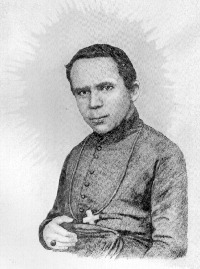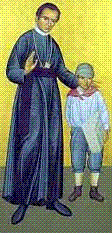St. John Nepomucene Neumann (1811-1860)
HIS FASCINATING LIFE STORY
 The Bishop of Philadelphia lay crumpled in the snow a few blocks from
his new cathedral on Logan Square. By the time a priest reached him with the holy
oils, Bishop Neumann was dead. That was January 5, 1860. At his own request Bishop
Neumann was buried in a basement crypt in Saint Peter's Church where he would be with his
Redemptorist confreres.
The Bishop of Philadelphia lay crumpled in the snow a few blocks from
his new cathedral on Logan Square. By the time a priest reached him with the holy
oils, Bishop Neumann was dead. That was January 5, 1860. At his own request Bishop
Neumann was buried in a basement crypt in Saint Peter's Church where he would be with his
Redemptorist confreres.
PILGRIMAGES TO BISHOP'S TOMB
Almost immediately devout souls were drawn
to his grave. They came from far and near. More than a few were claiming
extraordinary miracles of grace. It was as though John Neumann, now dead, continued
his works of mercy among his people. For decades this unsolicited devotion
continued. Finally after many years and many incontrovertible miracles worked
through the intercession of this holy man, his Cause was introduced in Rome. In 1921
Pope Benedict XV saw fit to have John Neumann declared "Venerable". The
procession of the faithful continued and in 1963 Pope Paul VI declared him
"Blessed" John Neumann. The crowds of pilgrims prompted the building of
the lower church. His remains, remarkably well preserved after a century of
interment, were exhumed and placed in a glass encasement beneath the altar in the lower
church. Bus loads of pilgrims came from different parishes throughout the year to
pray to Saint John. Finally the long expected happened in Rome on 1977. Pope
Paul VI declared John Neumann a Saint in heaven.
Now pilgrims came from all over the world.
From his native Bohemia, from Germany and Holland they came to claim allegiance to
one of their own. Pope John Paul II made it a point to visit the Shrine when
he came to Philadelphia to attend the Eucharistic Congress. Yes, the City of
Brotherly Love was bursting with joy. The diocesan seminarians from St. Charles,
Overbrook, have made annual pilgrimages to his tomb. The various Irish Societies of
Philadelphia have made formal pilgrimages to the tomb of this humble man of God who, as
bishop, did so much for their immigrant forebears in the 1850's -- this
"foreigner" who went to the trouble of studying enough Irish to be able to hear
the confessions of those who "had no English," up in the coal regions of
nineteenth century Pennsylvania.
Those of Italian extraction remember Bishop Neumann as the founder of
the first national parish for Italians in the United States. At a time when there
was no priest to speak their language, no one to care for them, Bishop Neumann, who had
studied Italian as a seminarian in Bohemia, gathered them together in his private chapel
and preached to them in their mother tongue. In 1855 he Purchased a Methodist Church
in South Philadelphia, dedicated it to St. Mary Magdalene de Pazzi, and gave them one of
his seminary professors, Father John Tornatore, C.M., to be their pastor.
CATHOLIC SCHOOL SYSTEM ESTABLISHED
 Bishop Neumann lays several claims to fame in Philadelphia and the
United States. Ever a humble and self-effacing person, he would be the last one to
mention it himself, but the records stand. It was he who organized the first
diocesan schedule of the Forty Hours' Devotion in America. The credit is likewise
his of establishing the first system of parochial schools in various parts of the country
when Neumann came to Philadelphia -- but the first unified system of Catholic schools
under a diocesan board. This he did in may of 1852, a fortnight before the
Plenary Council at Baltimore which seconded his proposals.
Bishop Neumann lays several claims to fame in Philadelphia and the
United States. Ever a humble and self-effacing person, he would be the last one to
mention it himself, but the records stand. It was he who organized the first
diocesan schedule of the Forty Hours' Devotion in America. The credit is likewise
his of establishing the first system of parochial schools in various parts of the country
when Neumann came to Philadelphia -- but the first unified system of Catholic schools
under a diocesan board. This he did in may of 1852, a fortnight before the
Plenary Council at Baltimore which seconded his proposals.
FOUNDER OF SISTERS OF ST. FRANCIS
He may also lay claim to being founder of a religious order for
women, the Third Order of St. Francis of Glen Riddle, whose Rule he drafted in 1855 after
returning from Rome for the solemn promulgation of the dogma of the Immaculate Conception.
The School Sisters of Notre Dame likewise regard Bishop Neumann as
their secondary founder, their "father in America." In 1847, Father John
Neumann, superior of the Redemptorist Order at the time, welcomed the first band of
these teaching sisters from Munich. He found them a home in Baltimore and then
provided them with teaching assignments in his Order's parish schools at Baltimore,
Pittsburgh, New York, Buffalo and Philadelphia.
A REDEMPTORIST
Bishop Neumann, as a young priest, was the first to make his
religious profession as a Redemptorist in the New World. This he did in 1842 in the
Church of St. James in Baltimore. Before his elevation to the See of Philadelphia at
the age of 41, he had served as rector of St. Philomena's, Pittsburgh, and St. Alphonsus,
Baltimore, as well as vice-provincial of this missionary order in America.
Recent research in the files of the State Department show that Bishop
Neumann became a naturalized citizen of the United States at Baltimore on February 10,
1848, renouncing allegiance to the Emperor of Austria in whose realm he was born on March
28, 1811. On his 41st birthday, he was consecrated bishop of Philadelphia by
Archbishop Francis Kenrick at St. Alphonsus Church in Baltimore, in 1852.
A DIOCESAN PRIEST
Before joining the Redemptorists John N. Neumann labored as a
diocesan priest in Western New York. He was ordained in June of 1836 by Bishop John
Dubois at old St. Patrick's Cathedral on Mott Street, New York City. The following
week he was pastor of the whole Niagara Frontier, some hundred square miles of swampy
primeval forest. Many German immigrants had settled this sector of the diocese
and were in danger of losing the Faith. It was for this reason that Father
Neumann was sent there. He built churches, raised log schools where possible and
even taught the three R's himself to the German and Irish children.
"Among the shepherds of the flock in Philadelphia," wrote
the late Pope Pius XII, on the occasion of the 150th anniversary of the founding of the
diocese, "the figure of Venerable John Neumann is pre-eminent. It was mainly
through his prodigious efforts that a Catholic school system came into being and that
parochial schools began to rise across the land. His holy life, his childlike
gentleness, his hard labor and his tremendous foresight is still fresh and green among
you. The tree planted and watered by Bishop Neumann now gives you its fruit."
James J. Galvin C.Ss.R.
THE IMMIGRANT SHEPHERD
It was fitting indeed that Bishop Neumann was beatified during the
Second Vatican Council. In a personal letter to each bishop of the world, before the
opening of the Council, the Holy Father asked each bishop to aim at achieving the heights
of personal sanctity in order to assure its success. He reminded them of their first and
highest mission of carrying on a constant policy of instruction and of pastoral visitation
so that they can say: "I know my sheep, each and every one," and that one of the
great blessings that can come to a diocese is a bishop who sanctifies, who keeps watch and
who sacrifices himself. All these qualities are pre-eminent in the life and holiness
of Bishop Neumann, the shepherd declared Blessed during this council.
PRAYER FOR HIS INTERCESSION
O Saint John Neumann, your ardent desire of bringing all
souls to Christ impelled you to leave home and country; teach us to live worthily in the
spirit of our Baptism which makes us all children of the one Heavenly Father and brothers
and sisters of Jesus Christ, the first-born of the family of God.
Obtain for us that complete dedication in the service of the
needy, the weak, the afflicted and the abandoned which so characterized your life. Help us to walk perseveringly in the difficult and, at times, painful paths of duty,
strengthened by the Body and Blood of our Redeemer and under the watchful protection of
Mary our Mother.
May death still find us on the sure road to our Father's
House with the light of living Faith in our hearts. Amen.
 The Bishop of Philadelphia lay crumpled in the snow a few blocks from
his new cathedral on Logan Square. By the time a priest reached him with the holy
oils, Bishop Neumann was dead. That was January 5, 1860. At his own request Bishop
Neumann was buried in a basement crypt in Saint Peter's Church where he would be with his
Redemptorist confreres.
The Bishop of Philadelphia lay crumpled in the snow a few blocks from
his new cathedral on Logan Square. By the time a priest reached him with the holy
oils, Bishop Neumann was dead. That was January 5, 1860. At his own request Bishop
Neumann was buried in a basement crypt in Saint Peter's Church where he would be with his
Redemptorist confreres.
 Bishop Neumann lays several claims to fame in Philadelphia and the
United States. Ever a humble and self-effacing person, he would be the last one to
mention it himself, but the records stand. It was he who organized the first
diocesan schedule of the Forty Hours' Devotion in America. The credit is likewise
his of establishing the first system of parochial schools in various parts of the country
when Neumann came to Philadelphia -- but the first unified system of Catholic schools
under a diocesan board. This he did in may of 1852, a fortnight before the
Plenary Council at Baltimore which seconded his proposals.
Bishop Neumann lays several claims to fame in Philadelphia and the
United States. Ever a humble and self-effacing person, he would be the last one to
mention it himself, but the records stand. It was he who organized the first
diocesan schedule of the Forty Hours' Devotion in America. The credit is likewise
his of establishing the first system of parochial schools in various parts of the country
when Neumann came to Philadelphia -- but the first unified system of Catholic schools
under a diocesan board. This he did in may of 1852, a fortnight before the
Plenary Council at Baltimore which seconded his proposals.